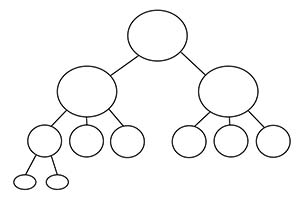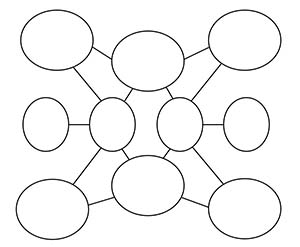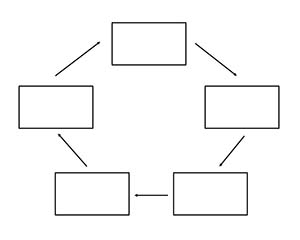INNOVATIVE TEACHING SHOWCASE
IDEAS
Idea 7: Concept Mapping
Concept Maps “engage students by challenging them to synthesize and be creative as they organize their hierarchy of associations into a meaningful graphic.”2
Learning Intention
Useful for uncovering students’ prior knowledge or assumptions about a topic as well as engaging students in exploring a concept in a variety of ways, concept maps help students organize and synthesize ideas. In the context of inquiry-based learning, students can use concept maps to brainstorm questions, explore a topic, analyze causes, and propose solutions to problems.
Overview
Individually, in pairs, or in small or large groups, students brainstorm ideas connected to a central question, topic, issue, or problem and develop visual representations of the relationships between those ideas. Instructors can provide students a template to fill in or give students the freedom to create their own diagrams.
Instructions
- Determine the central theme or concept you want students to explore and develop a prompting question for students to consider. For example, students could be asked to define what counts as art, identify causes or effects of a major historical event, reflect on their current assumptions, or analyze the pros and cons of a particular problem-solving strategy.
- Prepare resources for students. Whether you want students to brainstorm together on easel paper with crayons, use whiteboard markers and the classroom whiteboard, fill out photocopied maps, or use a graphic design computer program to create their concept maps, you will need to gather the necessary materials.3
- Provide opportunities for students to interact. Brainstorming together during the process of building their concepts maps, presenting their maps to classmates, and interrogating or appreciating one another’s diagrams can all add powerful depth and dimension to students’ insights about the topic.2
- Close the exercise by highlighting the way the concept maps can inform continued learning in the course. For example, they might establish questions to be answered through the course, encourage critical assessment of ideas, or guide the process of inquiry or discovery.



Considerations
- Visual learners are likely to be energized by concept maps, while verbal learners may feel frustrated by them. Encourage students to stretch themselves or allow them to find alternative ways to represent ideas and relationships, such as through music, movement, or poetry.
- Create your own concept map before asking students to create one. It might even be helpful to walk through the process together or offer examples of concept maps to students who are unfamiliar with charting relationships between ideas.
- Angelo, T. A. & Cross, K. P. (1993). Classroom Assessment Techniques. San Francisco, CA: Jossey-Bass, pp. 197-202.
- Barkley, E. F. (2012). Student Engagement Techniques: A Handbook for College Faculty. San Francisco, CA: Jossey-Bass, pp. 219-225.
- Graphic Organizers for Education (no date). Printable online graphic organizers.


